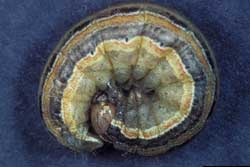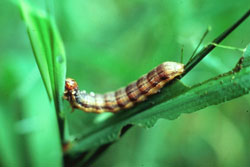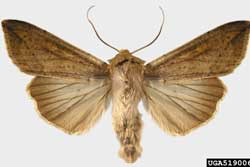Armyworms—Mythimna unipuncta (formerly Pseudaletia unipuncta)
Armyworms get their name from their behavior of moving across fields in an army-like fashion. As larvae consume available food sources, they migrate as an army to new host plants. Though they feed primarily on grasses (oats, wheat, fall rye, corn, barley, and forage grasses), they can be a pest of some vegetables (bean, cabbage, carrot, onion, pea, pepper, radish and sweet potato).

Armyworm larvae vary in color from dark greenish-brown to black. On each side, there are long, pale white, orange, and dark brown stripes along the length of the abdomen. Mature larvae are approximately 1½ inches long.
Click on images to view full-size
Identification and Control Information
- Pest Management Fact Sheet: Armyworms—University of Maine Cooperative Extension
[Photos, left to right: Frank Peairs, Colorado State University, Bugwood.org; North Carolina Forest Service Archive, Bugwood.org; Natasha Wright, Florida Department of Agriculture and Consumer Services, Bugwood.org]

